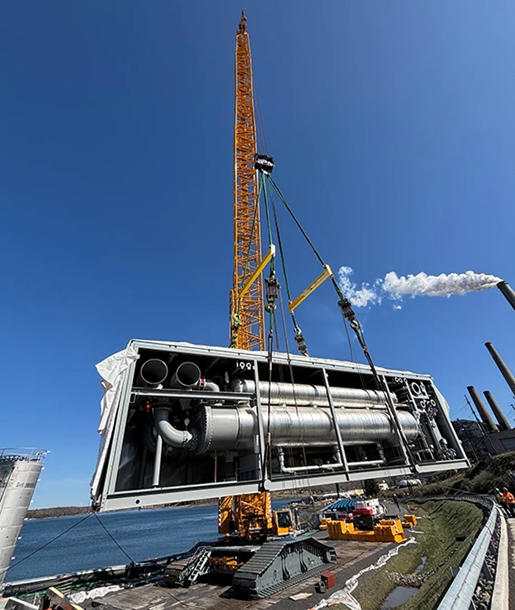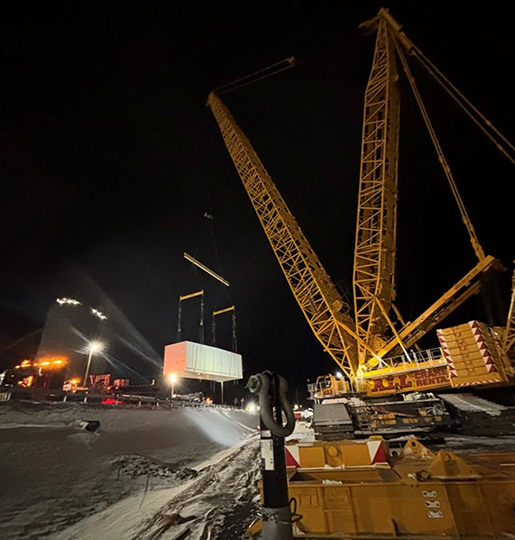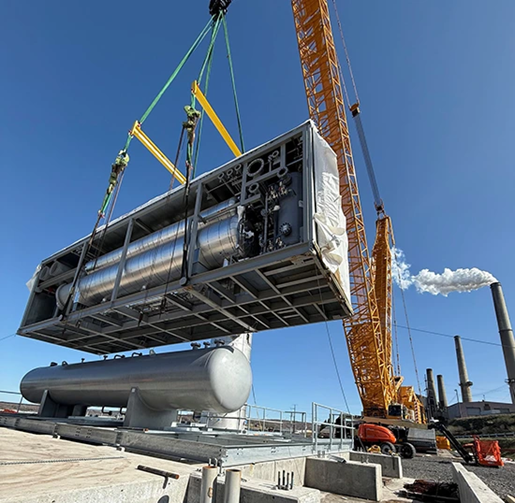
Mount Storm Lake in West Virginia is a large body of water (1200 acres) with an even more outsized impact on its region, due to its proximity to Dominion Energy’s Mount Storm Power Station. As the cooling lake for the power station, it aids in power generation for more than two million customers. As a byproduct of this role, the lake also remains a steady 60 degrees, making it an attractive year-round recreation destination for scuba divers, boaters and anglers.
The reason for this constant temperature is the collection of chillers employed by the power station, which cool down the water before it is pumped back into the lake. So when the time came to update these chillers with new units, Mineral Fabrication & Machine sought heavy lift equipment with the capacity, reach, and steadiness required for such an important job. Lift partner ALL Crane & Equipment Rental Corp. of West Virginia, a member of the ALL Family of Companies, specified the impressive Liebherr LR 1800-1.0 lattice boom crawler crane.
The Liebherr LR 1800-1.0 offers a 374-foot main boom, among the longest available, and a lift capacity of 880 tons, making it one of the most versatile cranes of its class.
Gary Dodd, sales representative with ALL Crane & Equipment Rental Corp., used the onboard LICCON 2 (Liebherr Crane Control) system to help generate approximately 30 lift plans for the various operations to be executed by the LR 1800. “We were performing lifts from a variety of radii,” said Dodd. “Anywhere from 85 feet to 210 feet.”
In addition to lifting chiller units, the crane also lift the steel needed for support structures for the chillers. Dodd estimates the heaviest piece to be lifted weighed in at 188,000 pounds.
The LR 1800 was configured with 276 ft main boom in what Liebherr dubs the “HSLDBV boom system.” This configuration includes main boom (HSL), the derrick system (D) and the new suspended ballast with adjustable frame, the “V frame” (BV).
The crane’s exclusive V-frame derrick enables enormous adjustment distances in ballast radius, delivering maximum flexibility compared to the standard, rigid system. It also makes the LR 1800 more maneuverable while simplifying use of the derrick to save valuable time on a job site.
Ground bearing pressure
Because of the plant’s close proximity to the lake, the lift team paid careful attention to ground bearing pressures. The concern was that moisture from the lake could seep into surrounding ground and weaken it.
“Ground bearing pressure is always a consideration in plant environments,” said Dodd. “Especially here, given the size of the crane and the weight of loads.”
A custom-engineered pad was employed, which kept ground bearing pressure at a maximum of 38 pounds per square inch.
Another feature of the LR 1800 that was used to great effect on the job site was VarioTray, a detachable ballast system that saves the need for stacking and unstacking on a job. Once the acceptable ground bearing pressure had been determined and all lift plans completed, the ALL team used VarioTray to customize the counterweight package for each lift to make sure it stayed under the required 38 pounds per square inch.
“For just about every lift, we had to either put weight on or take weight off the ballast tray,” said Dodd. “The LR 1800 is designed to be able to do this relatively quickly. Because with some loads, you’ll be picking way out there at 200 feet, so your ground bearing pressure is going to be out on the toe of the tracks. We’re able to load up the tray to keep weight evenly distributed.”
Counterweight needed ranged from 54,000 pounds on the low end all the way up to 385,000 pounds. In all, the Liebherr LR 1800-1.0 met every challenge demanded of it. “This machine is a beast,” said Dodd. “Mount Storm got its name because wind and weather can indeed be stormy up there. The LR 1800 took everything in stride, executing lifts smoothly and with precision.”
In addition to the cutting-edge machinery, Dodd also credits the people doing the work with the success of the operation. “The Mineral Fabrication team made this a true collaboration,” said Dodd. “The working relationship between our organizations enabled us to act in lockstep to achieve the project objectives.”
He also points to the members of the ALL crew, including those who assembled the LR 1800 in tight quarters, using a laydown area in a different part of the plant for staging, the crane operators who performed the lifts, and the assist team that maintained the counterweight tray at the appropriate weights.


